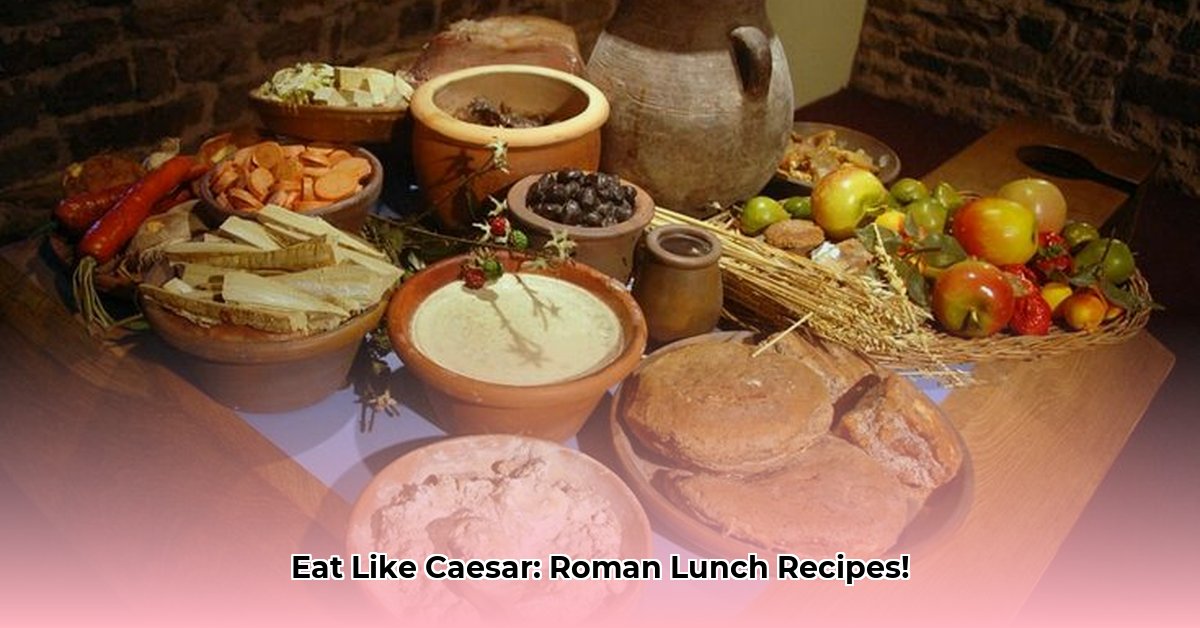Ever wondered what kind of midday meal fueled the minds and might of ancient Rome? Forget your usual sandwich and prepare to embark on a delectable journey back in time. For more inspiration, see these ancient Roman recipes. We’re not just talking about history; we’re inviting you into your kitchen to recreate the surprisingly accessible and deeply flavorful ancient Roman lunch recipes (known as prandium). This guide will unlock the secrets of Roman gastronomy, offering easy-to-follow recipes using ingredients you can find today, alongside insights into the culinary traditions that shaped one of the greatest empires in history. Get ready to transform your lunch into a feast worthy of a Roman citizen!
The Roman Midday Meal: An Empire’s Energizer
Unlike the elaborate cena (dinner) often portrayed in movies, the prandium or midday meal for most Romans was a practical affair. It was typically a light, quick, and informal repast, designed to sustain them through their busy day, whether they were senators, merchants, or soldiers. For the common folk, this often meant grain-based dishes, vegetables, cheese, and pulses. The wealthy might enjoy a broader selection, but convenience and nutrition remained key.
Imagine a Roman “lunchbox.” What treasures would it hold? Typically, you’d find:
- Bread (
panis): Often a simple, unleavened bread, sometimes accompanied by olives or cheese. - Puls (
porridge): A hearty, thick porridge made from grains like spelt or barley, often seasoned with herbs, cheese, or even meat. It was a foundational dish, providing substantial energy. - Vegetables & Pulses: Cabbage, leeks, onions, garlic, lentils, beans, and chickpeas were dietary staples, offering vital nutrients.
- Cheese (
caseus): Fresh or aged, cheese was a common accompaniment, adding flavor and protein. - Olive Oil (
oleum): The omnipresent liquid gold, used liberally for cooking, dressing, and preservation. - Fruits: Seasonal fruits like figs, dates, grapes, and apples provided natural sweetness.
- Wine (
vinum): Often diluted with water, wine was a common beverage, not just for pleasure but also for its perceived health benefits and to make potentially unsafe water potable.
But what truly defined the Roman palate were a few distinctive flavor enhancers, chief among them, garum.
Garum: The Ancient Umami Powerhouse
No discussion of Roman cuisine is complete without garum, the fermented fish sauce that was the undisputed king of Roman condiments. Far from being an obscure ingredient, garum permeated nearly every dish, providing a deep, savory flavor akin to what we now call umami. Made by fermenting small fish (like anchovies or mackerel) with salt in the sun, it was available in various qualities, from clear, expensive varieties to thicker, more pungent pastes. Its versatility was unmatched; Romans used it as a seasoning, a sauce base, and even as a table condiment, much like we use soy sauce or ketchup today.
Authentic garum is challenging to source, and making it at home is a lengthy, odorous process best suited for specialized enthusiasts. However, for the modern cook eager to capture that distinctive Roman essence, high-quality Asian fish sauce is an excellent and readily available substitute. Its salty, savory, pungent profile closely mimics the effect garum had on Roman dishes. For an extra layer of depth, a tiny touch of anchovy paste can be added.
Garum Modern Substitutes Comparison Table
Ready to infuse your Roman-inspired lunches with authentic-tasting depth? Here’s how readily available substitutes can bring ancient flavors to your modern kitchen:
| Substitute | Flavor Profile | Availability | Notes |
|---|---|---|---|
Thai Fish Sauce (Nam Pla) | Salty, intensely savory, pungent umami | Widely Available | A fantastic starting point. Look for brands with minimal additives like sugar, prioritizing pure fish and salt for a cleaner, more historically accurate flavor profile. Ideal for general seasoning and saucing. |
Vietnamese Fish Sauce (Nuoc Mam) | Often more nuanced, slightly sweeter, complex umami | Widely Available | Can offer a more refined and layered flavor, potentially closer to the higher-quality garum varieties. Excellent for subtle enhancements and finishing dishes where depth is desired without overpowering other ingredients. |
| Anchovy Paste/Extract | Concentrated fish flavor, very salty, robust | Specialty Grocers | Use sparingly as a powerful flavor booster. A small amount, when dissolved into other liquids or mixed with fish sauce, can significantly amplify the fishy intensity, making your substitute even closer to the historical garum experience. |
| Fermented Black Bean Paste | Salty, earthy, deeply savory | Asian Markets | While not fish-based, its intense fermented umami can provide a similar grounding flavor in hearty stews and vegetable dishes. A unique alternative for those avoiding fish products or seeking a different depth of flavor. |
Silphium: A Taste From the Past, Lost to Time
While garum remains reproducible, another iconic Roman flavor, silphium, is tragically lost to history. This highly prized plant, once abundant in North Africa, was celebrated for its pungent, resinous, and slightly garlicky aroma, used in both medicine and cuisine. Unfortunately, due to unsustainable harvesting, it was driven to extinction around the 1st century CE.
Today, we can only imagine its unique taste. Culinary historians suggest that a complex blend of asafoetida (hing) for its garlicky, sulfurous notes, combined with fennel seeds for a hint of licorice, and a touch of rue, mint, or parsley for herbaceous brightness, might approximate its elusive character. While we can’t truly recreate it, contemplating silphium reminds us of the rich, diverse, and sometimes ephemeral nature of ancient gastronomy. For the purpose of our practical recipes, we will focus on flavors achievable with modern ingredients, but keeping silphium in mind adds a layer of historical intrigue.
Ancient Roman Lunch Recipes: Your Culinary Time Machine
These recipes are adapted to be simple and approachable, inviting you to experiment with historical flavors without needing a complete overhaul of your pantry.
Recipe 1: Moretum – The Roman Farmer’s Zesty Cheese Dip
Moretum was a quintessential Roman dish, a versatile cheese and herb spread often prepared by farmers. The poet Virgil even dedicated a poem to its preparation, highlighting its foundational role in the daily meal. Think of it as an ancient Roman pesto or a savory, herby hummus, perfect for dipping bread or fresh vegetables.
Ingredients:
| Ingredient | Quantity | Notes |
|---|---|---|
| Fresh Ricotta Cheese | 1 cup (8 oz) | Opt for a high-quality, whole-milk ricotta for creaminess. For a more authentic, saltier, and tangier flavor, use finely crumbled Pecorino Romano cheese or a blend of both. |
| Fresh Herbs | 1/4 cup total | A vibrant mix is key: finely chopped parsley, mint, and cilantro are excellent. You can also include a small amount of fresh rue or dill for a more ‘ancient’ herbaceousness (use sparingly, as rue has a strong, bitter flavor). |
| Garlic | 2-3 cloves | Minced very finely or crushed into a paste. The more you crush, the more pungent and integrated the garlic flavor will be. |
| Extra Virgin Olive Oil | 1 tablespoon | A good quality, robust olive oil is essential. It binds the ingredients, adds richness, and contributes a fruity, peppery note. |
| Red Wine Vinegar | 1 teaspoon | Adds a crucial tangy counterpoint that brightens the rich cheese and herbs. |
| Fish Sauce | 1/4 teaspoon | As your garum substitute. Start with a tiny amount (a few drops) and add more gradually, tasting as you go. It’s potent. |
| Sea Salt | To taste | Adjust based on the saltiness of your cheese and fish sauce. |
| Freshly Ground Black Pepper | To taste | Grind generously for a pungent, aromatic kick that complements the herbs and cheese. |
Instructions:
- Prepare the Aromatics: If you have a mortar and pestle (the traditional Roman way!), start by mashing the garlic cloves until they form a smooth paste. This releases their potent oils and forms the aromatic foundation. If not, finely mince the garlic.
- Infuse the Herbs: Add the fresh herbs to the garlic (in the mortar or a small bowl) and continue to grind or press them together. This step is crucial for releasing their vibrant essential oils, creating a deeply fragrant and integrated base.
- Combine & Mix: In a medium-sized mixing bowl, combine the cheese, the fragrant garlic-herb paste, olive oil, and red wine vinegar. Mix vigorously with a fork or spoon until all ingredients are thoroughly combined and the mixture is smooth and creamy. The texture should be spreadable but still retain some body.
- Add the Umami Boost: Now, carefully stir in the fish sauce (
garumsubstitute). Remember, less is often more here. Integrate it fully, allowing its savory depth to meld with the other flavors. - Season to Perfection: Taste the
moretum. Adjust the seasoning with additional salt and freshly ground black pepper as needed. You want a harmonious balance where no single flavor dominates, but all contribute to a rich tapestry. - Chill & Serve: For best results, cover the bowl and refrigerate for at least 30 minutes. This allows the flavors to truly meld and deepen, enhancing the complexity.
Serving Suggestion: Serve your homemade moretum with slices of warm, crusty bread (a rustic Italian loaf or even pita bread works wonderfully). It’s also delicious as a dip for crisp vegetables like cucumber, celery sticks, or carrot rounds, or spread onto flatbreads for a quick, flavorful bite. It’s an ideal appetizer or a hearty component of a Roman-inspired lunch platter.
Recipe 2: Roman Lentil & Vegetable Stew – A Hearty Puls Variation
Puls, a versatile grain porridge, was a cornerstone of the Roman diet, providing sustenance and warmth, particularly for the working class. This modern adaptation of a Roman lentil stew captures the essence of a hearty puls while offering a rich, flavorful, and incredibly nutritious meal. It’s perfect for a satisfying lunch that delivers both comfort and historical flavor.
Ingredients:
| Ingredient | Quantity | Notes |
|---|---|---|
| Brown or Green Lentils | 1 cup | Rinsed thoroughly under cold water to remove any debris and to prevent foaming during cooking. These varieties hold their shape well, providing good texture. |
| Vegetable Broth | 4-5 cups | Use a good quality, low-sodium vegetable broth as the base. Chicken broth can also be used for a richer flavor profile. |
| Yellow Onion | 1 medium | Finely chopped to melt into the stew, providing a sweet aromatic foundation. |
| Carrots | 2 medium | Diced. Adds natural sweetness, vibrant color, and essential nutrients. |
| Celery Stalks | 2 | Diced. Contributes a subtle savory bitterness and texture. |
| Garlic | 3-4 cloves | Minced. A generous amount for its robust aroma and flavor, a hallmark of ancient Mediterranean cooking. |
| Dried Thyme | 1 teaspoon | Adds a warm, earthy, and slightly peppery herbal note that complements legumes beautifully. |
| Ground Coriander | 1/2 teaspoon | Offers a unique citrusy, earthy, and slightly sweet flavor, often found in ancient Roman recipes. |
| Ground Cumin | 1/4 teaspoon | Provides a warm, pungent, and slightly bitter depth often used in historical Middle Eastern and Mediterranean cooking, enhancing the overall spice profile. |
| Extra Virgin Olive Oil | 2 tablespoons | Essential for sautéing vegetables and adding richness to the stew. Use good quality for maximum flavor. |
| Bay Leaf | 1-2 | Adds a subtle, savory, and slightly peppery depth that slowly infuses during simmering. Remember to remove before serving. |
| Sea Salt | To taste | Crucial for seasoning and bringing out the natural flavors of the ingredients. |
| Freshly Ground Black Pepper | To taste | Adds warmth and a pungent kick. |
| Red Wine Vinegar | 1-2 tablespoons | A splash at the end provides a bright, tangy finish that cuts through the richness and enhances the overall flavor. |
| Fish Sauce | 1-2 teaspoons | Your garum substitute. Add cautiously and taste, as its intensity can vary. It will provide that crucial umami depth. |
| Fresh Parsley | 1/4 cup | Chopped, for garnish. Adds freshness and a vibrant green color just before serving. |
Instructions:
- Prepare the Base: In a large, heavy-bottomed pot or Dutch oven, heat the olive oil over medium heat. Add the chopped onion, carrots, and celery. Sauté gently for 7-10 minutes, stirring occasionally, until the vegetables soften and the onion becomes translucent but not browned. This step builds the foundational flavors.
- Infuse Aromatics & Spices: Stir in the minced garlic, dried thyme, ground coriander, and ground cumin. Cook for another 1-2 minutes, stirring constantly, until the spices are fragrant. Be careful not to burn the garlic.
- Add Lentils & Liquid: Add the rinsed lentils and the bay leaf to the pot. Pour in the vegetable broth. Bring the mixture to a vigorous boil over high heat, then immediately reduce the heat to low.
- Simmer to Perfection: Cover the pot and let the stew simmer for 40-50 minutes, or until the lentils are completely tender and creamy. Stir occasionally to prevent sticking to the bottom of the pot. If the stew becomes too thick, you can add a little more broth or water.
- Season & Finish: Once the lentils are cooked, remove the bay leaf. Season generously with salt and freshly ground black pepper to taste. Now, stir in the red wine vinegar for a bright tang and the fish sauce (
garumsubstitute) for that quintessential Roman umami depth. Taste and adjust seasonings as needed, ensuring a balanced and rich flavor. - Serve: Ladle the hot lentil stew into bowls. Garnish generously with fresh chopped parsley before serving.
Variations & Serving Suggestions:
To make this stew even more authentic, consider incorporating elements Romans would have enjoyed:
* Meat: For a heartier meal, brown some diced pancetta, bacon, or even small pieces of pork or lamb with the initial vegetables.
* Greens: Stir in a handful of fresh spinach or kale during the last 5 minutes of cooking for added nutrients and color.
* Garnish: A drizzle of high-quality extra virgin olive oil just before serving adds a luxurious finish. You could also crumble a bit of hard cheese (like Pecorino Romano) on top.
This stew is a complete meal on its own, but it pairs beautifully with sturdy bread for dipping, or a simple green salad dressed with olive oil and vinegar.
Recipe 3: Dulcia (Honeyed Dates with Nuts) – A Sweet Roman Treat
For a light midday dessert or a sweet energy boost, Romans often turned to natural sugars from fruits and honey. Dulcia refers to various sweet confections, and a simple, yet elegant option involved honey and nuts, reflecting the Mediterranean bounty. This recipe is quick to prepare and offers a delightful balance of sweetness and rich texture, perfect as an ending to your prandium.
Ingredients:
| Ingredient | Quantity | Notes |
|---|---|---|
| Large, Pitted Dates | 12-15 (Medjool preferred) | Choose plump, soft dates for the best texture and natural sweetness. Medjool dates are ideal. |
| Mixed Nuts | 1/4 cup | Finely chopped almonds, walnuts, or pine nuts work well. Roasting them lightly enhances their flavor and crunch. |
| Honey | 2 tablespoons | A good quality local honey will offer a rich, floral sweetness. Adjust quantity to your desired sweetness level. |
| Ground Cinnamon | 1/4 teaspoon | Adds a warm, aromatic spice note that was popular in ancient Roman cuisine. |
| Pinch of Salt | Just a tiny pinch to enhance the sweetness and balance the flavors. | |
| Fresh Mint Leaves | Optional, for garnish | A few finely chopped mint leaves can add a refreshing counterpoint and visual appeal. |
Instructions:
- Prepare the Dates: If your dates are not already pitted, slice them lengthwise










